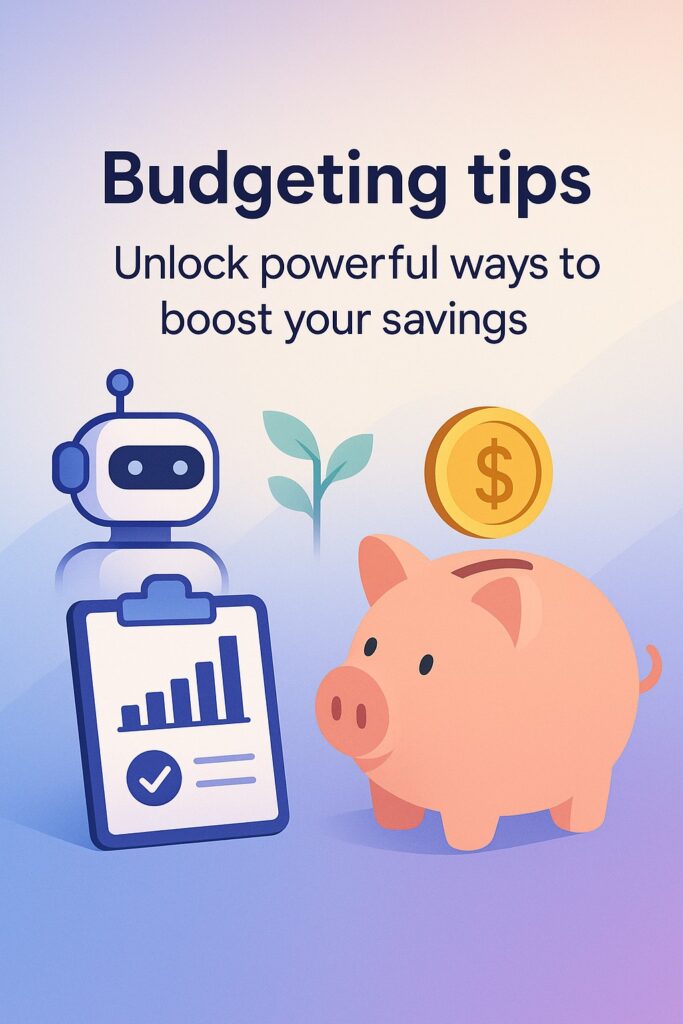Struggling to save money as a student? These easy saving strategies will help you keep more cash, spend smarter, and stress way less—starting today.
Saving money isn’t always easy—especially when you’re a student. Between books, snacks, hangouts, and sudden plans, cash disappears fast. That’s where saving strategies come in.
So, what are they? Saving strategies are simple plans or habits that help you keep more of your money. They show you how to spend smarter, save regularly, and avoid running out of cash when you need it most.
Whether you’re saving for a trip, a new gadget, or just want to stop feeling broke by the end of the month, the right saving strategies can make a big difference.
You don’t need to be a finance expert. You just need smart steps that work for your lifestyle. Let’s break it all down and find the saving tips that actually stick.
Table of contents
- Saving strategies with AI-powered budgeting tools
- Best smart savings apps for student saving strategies
- How machine learning boosts your saving strategies?
- Top automated saving strategies using AI in 2025
- Saving strategies with the best fintech tools
- How AI improves financial planning and saving strategies?
- How AI improves financial planning and saving strategies?
- How AI improves financial planning and saving strategies?
- Boost saving strategies using predictive analytics
- Top budgeting apps with AI saving strategies built in
- FAQs: Saving strategies
- Conclusion
Saving strategies with AI-powered budgeting tools

Use smart apps to track, save, and stay in control. AI-powered budgeting tools are changing the way you manage money. These apps do more than just show where your cash goes—they help you save smarter without overthinking it. For students juggling studies, side hustles, and social life, this makes a huge difference.
Use AI to learn your habits
These tools don’t just track—they learn. Apps like Cleo, Emma, or Charlie study your spending patterns. If you always spend more on weekends or order too much food during finals, the app notices. It then gives you custom tips—like “skip the second coffee today” or “save $5 instead of spending it on snacks.”
These real-time nudges turn into solid saving strategies. You’re not just told what to do—you’re shown why it matters. And when advice is this personal, it’s easier to follow.
Set smart savings goals
With AI tools, setting goals is simple. Just tell the app what you want—like saving $100 for a trip or $30 for a birthday gift. The app then breaks it into small, daily targets. It might move $1 from your account today, $2 tomorrow—without you lifting a finger.
That’s one of the best saving strategies: let the tech do the work. You don’t need to plan every penny. The app keeps your savings steady, even when life gets busy.
Stay updated without stress
AI tools send friendly updates and alerts. They tell you when you’re close to overspending or when you’ve hit your savings goal. Some even talk to you in chat-style messages that feel like texting a friend.
These features make saving strategies fun and easy to stick with. You’re always in the loop without feeling overwhelmed.
So if you’re tired of budgeting spreadsheets or forgetting where your money went, AI tools are here to help. They take the pressure off and make saving feel natural—even fun.
Best smart savings apps for student saving strategies
Make your phone the smartest way to save money. Not great at saving money? Don’t worry—there’s an app for that. Actually, there are tons. But some are perfect for students who want to build simple saving habits without stress. These apps are designed to support real saving strategies that actually work for student life.
Cleo: fun, chat-style money tracking Saving strategies
Cleo feels more like texting a friend than using a finance app. It watches your spending, sets fun savings challenges, and even roasts your bad money habits (in a funny way). You can ask Cleo, “How much can I save this week?” and it’ll give you a plan.
This app makes saving strategies more engaging. It’s not just numbers—it’s advice with personality. Great for when you need help but don’t want anything too serious.
Qapital: automate your goals
Qapital is all about automation. Want to save $5 every time you skip takeout or walk to class instead of grabbing a ride? You can set custom rules like that. The app saves small amounts without you even noticing.
This kind of automatic saving turns smart ideas into real action. And it’s one of the easiest saving strategies for busy students who don’t want to think about money every day.
Wally: see where your money goes
Wally gives you a full picture of your income, expenses, and savings. It helps you spot habits you didn’t even know you had—like always overspending during exam weeks. Once you know where your money leaks, you can build better saving strategies fast.
Saving as a student doesn’t need to be hard or boring. These smart apps do the thinking, tracking, and planning for you. All you have to do is open the app—and start saving one tap at a time.
How machine learning boosts your saving strategies?

Smarter tech, better money moves. Machine learning sounds super high-tech—and it is—but it’s also helping students save money in the simplest ways. Apps powered by machine learning use your past spending to predict your future habits. This makes your saving strategies way more personal and way more effective.
It watches and learns how you spend
When you connect your bank account to apps like Cleo or Emma, they start learning your patterns. Spend more on food during finals? Always low on cash by the end of the month? Machine learning catches that. It then gives advice based on your real life—not some generic budget.
That’s why these apps make your saving strategies smarter over time. The more you use them, the better they guide you.
It gives predictions and nudges
Let’s say you usually spend more in December. A smart app will warn you in November and help you save a little extra before things get busy. This kind of heads-up is a game-changer. It’s like a money coach that knows your next move.
These predictive alerts turn your normal habits into better saving strategies—without making you feel guilty or confused.
It keeps your budget flexible
Life as a student changes fast. One week you’re spending on books, the next it’s movie nights and pizza. Machine learning adapts to that. It doesn’t just stick to a static budget. Instead, it shifts your plan based on what’s happening now.
This makes your saving strategies flexible, not frustrating. You can save even when life isn’t perfectly planned.
With machine learning, your money app starts to think ahead for you. That means less stress, fewer surprises, and more savings—without all the guesswork.
Top automated saving strategies using AI in 2025
Let the tech save for you while you focus on life. Saving money in 2025 doesn’t mean tracking every dollar manually. With AI, your savings can grow in the background—automatically. These tools make your saving strategies effortless by using smart rules and real-time data to move money without you lifting a finger.
Round-ups that add up
Apps like Qapital or Digit now use AI to round up your daily purchases. Buy a coffee for $3.60? The app rounds it to $4 and puts the extra $0.40 into savings. It’s small, but it adds up fast. You won’t even miss the extra change.
These micro-savings are one of the easiest saving strategies out there—especially when they happen without you even noticing.
Smart triggers that fit your life
Want to save $5 every time you skip takeout or hit your step goal? AI lets you set custom triggers that connect your money habits with your lifestyle. If you walk instead of Uber or cook dinner instead of ordering in, the app rewards you by saving for you.
These little wins turn into a strong foundation for your saving strategies, and they make it fun too.
Daily, weekly, or AI-picked transfers
You can also let the AI decide how much to save and when. Some tools check your balance, bills, and habits, then transfer small amounts you won’t miss. It could be $2 today and $7 next week. You don’t feel the pinch—but you see the results.
This is one of the smartest saving strategies in 2025: give AI full control, and let it grow your savings behind the scenes.
So if you’re busy with classes, work, or just life, these automated tools make sure your money isn’t sitting idle. With AI on your side, saving becomes automatic, easy, and kind of fun.
Saving strategies with the best fintech tools

Modern tools that make money management easier for students. Fintech tools aren’t just for professionals anymore. Today’s apps are built for students who want to spend smarter and save faster. Whether it’s tracking goals or cutting waste, the right fintech tools make saving strategies feel simple and doable.
Track everything in one place
Apps like Revolut, Monzo, or Chime give you a full view of your money. You can see how much you’re spending, where it’s going, and what you’ve saved—all from your phone. These tools sort your spending into categories so you know what’s draining your cash.
This clarity helps you shape better saving strategies. You can spot problem areas and adjust before things get out of hand.
Set limits and stick to goals Saving strategies
Fintech tools let you set custom limits for categories like food, shopping, or transport. Once you hit those limits, the app can notify you or even block more spending. That kind of instant feedback keeps you in control without needing to check your balance constantly.
It’s one of the easiest saving strategies because it turns goals into real actions. You don’t just plan to save—you actually follow through.
Save while you spend
Many fintech apps offer savings features that work alongside your regular spending. Some move spare change into a savings vault, while others stash away a percentage of your income automatically. You barely notice, but your money grows behind the scenes.
With these tools, your saving strategies become habits that work even when you’re not thinking about them.
If you want to save money without using spreadsheets or stressing about math, fintech tools are the way to go. They’re fast, flexible, and built to help you build smart habits early.
How AI improves financial planning and saving strategies?
Smarter tools for better money moves. AI isn’t just for robots or big companies—it’s also helping students plan their money better. With the right tools, AI can guide your daily choices, give smart suggestions, and make your saving strategies way easier to follow.
Personalized plans just for you
AI tools like Cleo or YNAB don’t give you random advice. Instead, they study your spending habits and income patterns. If you tend to spend more during exam weeks or weekends, the app knows. It then builds a financial plan that matches your lifestyle.
This personal touch helps your saving strategies actually work. You’re not trying to follow some one-size-fits-all plan—you’re following one made for you.
Real-time help when you need it
Let’s say you’re close to your budget limit. AI tools send a quick alert or message to let you know. Maybe it suggests holding off on that delivery or offers a cheaper option. These little reminders help you stay on track without feeling overwhelmed.
That kind of support makes your saving strategies stronger. You’re not just reacting—you’re making better choices in the moment.
Smart predictions for future goals Saving strategies
AI can even predict your future spending based on past behavior. If December is usually your most expensive month, it’ll help you start saving earlier. This kind of heads-up helps you avoid surprises and reach your goals without stress.
It’s one of the smartest ways to upgrade your saving strategies—by using tools that learn and plan ahead for you.
With AI, financial planning becomes clear, easy, and even kind of fun. You don’t need to be an expert to save well—you just need smart support at the right time.
How AI improves financial planning and saving strategies?

Smarter tools for better money moves. AI isn’t just for robots or big companies—it’s also helping students plan their money better. With the right tools, AI can guide your daily choices, give smart suggestions, and make your saving strategies way easier to follow.
Personalized plans just for you
AI tools like Cleo or YNAB don’t give you random advice. Instead, they study your spending habits and income patterns. If you tend to spend more during exam weeks or weekends, the app knows. It then builds a financial plan that matches your lifestyle.
This personal touch helps your saving strategies actually work. You’re not trying to follow some one-size-fits-all plan—you’re following one made for you.
Real-time help when you need it
Let’s say you’re close to your budget limit. AI tools send a quick alert or message to let you know. Maybe it suggests holding off on that delivery or offers a cheaper option. These little reminders help you stay on track without feeling overwhelmed.
That kind of support makes your saving strategies stronger. You’re not just reacting—you’re making better choices in the moment.
Smart predictions for future goals
AI can even predict your future spending based on past behavior. If December is usually your most expensive month, it’ll help you start saving earlier. This kind of heads-up helps you avoid surprises and reach your goals without stress.
It’s one of the smartest ways to upgrade your saving strategies—by using tools that learn and plan ahead for you.
With AI, financial planning becomes clear, easy, and even kind of fun. You don’t need to be an expert to save well—you just need smart support at the right time.
How AI improves financial planning and saving strategies?
Smarter tools for better money moves. AI isn’t just for robots or big companies—it’s also helping students plan their money better. With the right tools, AI can guide your daily choices, give smart suggestions, and make your saving strategies way easier to follow.
Personalized plans just for you
AI tools like Cleo or YNAB don’t give you random advice. Instead, they study your spending habits and income patterns. If you tend to spend more during exam weeks or weekends, the app knows. It then builds a financial plan that matches your lifestyle.
This personal touch helps your saving strategies actually work. You’re not trying to follow some one-size-fits-all plan—you’re following one made for you.
Real-time help when you need it Saving strategies
Let’s say you’re close to your budget limit. AI tools send a quick alert or message to let you know. Maybe it suggests holding off on that delivery or offers a cheaper option. These little reminders help you stay on track without feeling overwhelmed.
That kind of support makes your saving strategies stronger. You’re not just reacting—you’re making better choices in the moment.
Smart predictions for future goals
AI can even predict your future spending based on past behavior. If December is usually your most expensive month, it’ll help you start saving earlier. This kind of heads-up helps you avoid surprises and reach your goals without stress.
It’s one of the smartest ways to upgrade your saving strategies—by using tools that learn and plan ahead for you.
With AI, financial planning becomes clear, easy, and even kind of fun. You don’t need to be an expert to save well—you just need smart support at the right time.
Boost saving strategies using predictive analytics

Let smart data help you plan ahead. Predictive analytics sounds complex, but it’s super helpful for saving money—especially if you’re a student. It uses your past spending to guess what you’ll need in the future. That way, you can plan ahead without stress. These tools turn your saving strategies into smart, data-backed decisions.
Spot patterns before they repeat
Apps with predictive analytics look at how and when you usually spend. For example, if you always spend more during exam season or weekends, the app will notice. Then it can warn you early and suggest saving a little more in advance.
That makes your saving strategies smarter and more personal. You’re not just reacting to problems—you’re staying one step ahead.
Avoid money surprises
Ever had your account drop low and wonder where all your cash went? Predictive analytics helps stop that. It forecasts your future expenses so you’re not caught off guard. It might say, “Hey, you’ll probably spend $50 more next week—start saving now.”
This kind of alert turns good saving strategies into real results. You avoid last-minute panic and keep your spending under control.
Plan for short-term goals
Maybe you want to buy a concert ticket or save for a trip next month. Predictive tools help you break the goal into smaller steps based on your spending history. The app shows how much to save each week so you stay on track.
That turns basic saving strategies into solid, easy-to-follow action plans. No stress. No guesswork.
With predictive analytics, you’re not just tracking money—you’re making smarter choices before things even happen. It’s like having a future-focused money coach in your pocket.
Top budgeting apps with AI saving strategies built in
Smart apps that help you budget and save automatically. If you’re a student juggling expenses, budgeting apps with built-in AI can make life a lot easier. These apps don’t just track spending—they give you smart advice and help you grow savings without even trying. That’s why they’re perfect for modern saving strategies.
Cleo: chat-based saving with attitude
Cleo is fun, smart, and kind of sassy. It links to your bank account, tracks your spending, and gives personalized savings advice. It even sets up challenges to help you save faster—like the “No Spend Weekend” game.
With Cleo, you’re not just following basic saving strategies. You’re getting real-time feedback and having fun while doing it.
YNAB: perfect for goal-driven planning
You Need A Budget (YNAB) is great if you want full control over your money. It uses AI to help you plan where every dollar goes. You create categories, set goals, and let the app guide your spending.
This makes your saving strategies feel intentional. You’re not saving randomly—you’re building a plan that fits your real life.
Digit: saving in the background
Digit is all about automation. It studies your income and expenses, then moves small amounts of money into savings every day. You won’t even notice it, but your savings will grow over time.
It’s one of the easiest ways to turn passive habits into powerful saving strategies—with zero effort.
Budgeting apps with AI built in are like money coaches that fit in your pocket. They track your habits, adjust to your lifestyle, and guide your decisions. If you’re ready to start saving smarter, these tools make it super easy.
FAQs: Saving strategies
What are saving strategies for students?
Saving strategies are simple plans that help you keep money instead of spending it all. As a student, these can include setting spending limits, using apps to track your budget, or saving a little from each allowance or side job. The goal is to build good habits that stick.
How can I save money if I don’t earn much?
Start small. Even saving Rs.100 a week adds up. Use apps that move small amounts automatically or round up purchases. One of the best saving strategies is to save first, then spend what’s left. It works even with a low income.
Are there any saving strategies that don’t need apps?
Yes! You can use a notebook to track spending, put cash in labeled envelopes, or set weekly money challenges with friends. The key is to stay consistent. These old-school saving strategies still work really well.
How do I make saving a habit?
Try saving at the same time each week or after each payment. Set a small, clear goal like “save Rs.500 by the end of the month.” When you hit it, reward yourself (without overspending). These little wins keep your saving strategies going strong.
Should I save for big things or small things?
Both. Save for short-term things like gifts or events and long-term goals like a laptop or trip. Divide your money into different goals. That way, your saving strategies stay flexible and fun.
What’s one mistake to avoid in saving?
Don’t set goals that are too big or strict. It makes saving feel impossible. Start small and build up. Saving should feel good—not stressful. Stick with simple saving strategies that fit your life.
Conclusion
Saving money doesn’t have to be hard. With the right tools and habits, you can make real progress—even on a tight budget. Start small, stay consistent, and choose what works best for your life. Apps, AI, or simple tricks—they all help if you stick with them.
Saving strategies aren’t one-size-fits-all. Try different ones until something clicks. The goal is to build a routine that feels easy and natural. Over time, these saving strategies help you stress less and reach your goals faster. Whether it’s for fun, emergencies, or your future, every bit counts. You’ve got this—your future wallet will thank you.



